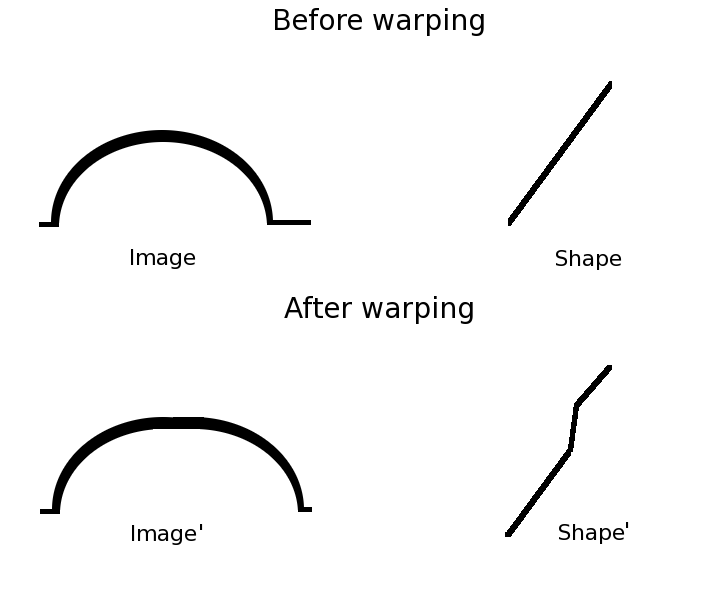 PDF version of this entire document
PDF version of this entire document
Shape drives the NRR in the sense that manipulating the shape component and then resampling the images makes NRR possible. Each image is sampled at a fixed number of points and shape determines the position of the points that are sampled.
The basic idea is demonstrated in Figure ![[*]](/IMG/latex/crossref.png) .
For a straight diagonal shape curve, each point on the bump is mapped
to an identical position after warping because any point along the
.
For a straight diagonal shape curve, each point on the bump is mapped
to an identical position after warping because any point along the
![]() axis in the shape curve coincides with the same value
on the
axis in the shape curve coincides with the same value
on the ![]() axis. If the shape curve is altered through warping,
then points on the bump are remapped accordingly, based on the new
shape curve. In order to build combined models, both components must
be taken into account so that variation of shape will be restricted
too.
axis. If the shape curve is altered through warping,
then points on the bump are remapped accordingly, based on the new
shape curve. In order to build combined models, both components must
be taken into account so that variation of shape will be restricted
too.

|
In order to show how 1-D images get registered, it is useful to provide different ways of visualising the data. The videos in the enclosed CD-ROM contain illustrations that are dynamic (time sequences) where warps are repeatedly applied, leading to change over time.
Dealing with several such bumps5.1 in turn, one can visualise them as shown in Figure ![[*]](/IMG/latex/crossref.png) and Figure
and Figure ![[*]](/IMG/latex/crossref.png) , where bumps are laid side
by side. Many of the auxiliary videos depict a 1-D registration using
this representation of the data. Figure
, where bumps are laid side
by side. Many of the auxiliary videos depict a 1-D registration using
this representation of the data. Figure ![[*]](/IMG/latex/crossref.png) has these images displayed as surfaces. Since the goal is to align
such images, such side-by-side presentation proves helpful.
has these images displayed as surfaces. Since the goal is to align
such images, such side-by-side presentation proves helpful.
![\includegraphics[scale=0.7]{Graphics/image_vectors}](img158.png)
|
![\includegraphics[scale=0.3]{Graphics/test_on_target_7-4}](img160.png)
|
An original, unwarped image is a function ![]() , where
, where
![]() is sampled at a set of equally-spaced points (which
are the pixel set,
is sampled at a set of equally-spaced points (which
are the pixel set, ![]() ).
).
Suppose there is a warp ![]() which collapses the unit interval
[0,1] onto itself, with no folds or tears. To transform images
in this way, it seems reasonable to employ clamped-plate splines because
they address such requirements given specific boundaries5.2. The clamped-plate splines prevent any of the regions in an image
from being torn or folded, hence they preserve the existence and integrity
of all image regions5.3.
which collapses the unit interval
[0,1] onto itself, with no folds or tears. To transform images
in this way, it seems reasonable to employ clamped-plate splines because
they address such requirements given specific boundaries5.2. The clamped-plate splines prevent any of the regions in an image
from being torn or folded, hence they preserve the existence and integrity
of all image regions5.3.
When the image is warped using biharmonic clamped-plate splines, the
set of previously equally-sampled pixel positions will move to new
positions ![]() and carry their image value with them. Two cases,
namely single-point and multi-point warps, were both considered, where
in the latter case composition is used to obtain more flexible deformations.
and carry their image value with them. Two cases,
namely single-point and multi-point warps, were both considered, where
in the latter case composition is used to obtain more flexible deformations.
Although the property of height was not intended to be ignored during registration (it is the maximum intensity, which cannot be discarded), it was expected that it would remain unchanged. This is due to the nature of CPS-based warps being used. They are perfectly diffeomorphic5.4[] provided that their constraints are obeyed. The warps are manipulated by altering the direction and magnitude of a single central knotpoint, or multiple knotpoints. Both cases were considered here and the warps were applied to localised parts of the line, not the entire line.
In the experiments described later, the bumps were all symmetric in
the sense that the curves were the same left and right of the centre
of the bump. The height, ![]() , took a single value value from a fixed
range set {hi, low} where
, took a single value value from a fixed
range set {hi, low} where ![]() and
and ![]() . The data
was therefore far simpler than 1-D data which is not constrained in
any way. The height of the bump and the position at which the bump
grows tall jointly defined the appearance that bump, so two real numbers
(a tuple) at the minimum sufficed for the reconstruction of each bump.
. The data
was therefore far simpler than 1-D data which is not constrained in
any way. The height of the bump and the position at which the bump
grows tall jointly defined the appearance that bump, so two real numbers
(a tuple) at the minimum sufficed for the reconstruction of each bump.
Roy Schestowitz 2010-04-05